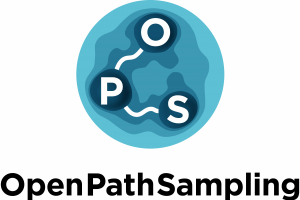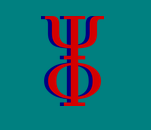Path density for OpenPathSampling

Module path density implements path density calculations for the OpenPathSampling (OPS) package, including a generic multidimensional sparse histogram, and plotting functions for the two-dimensional case. Path density plots provide a way to visualize kinetic information obtained from path sampling, such as the mechanism of a rare event. In addition, the code in this module can also be used to visualize thermodynamic information such as free energy landscapes.
This module has been incorporated into the core of OPS, an open-source Python package for path sampling that wraps around other classical Molecular Dynamics (MD) codes [1]. An easy-to-read article on the use of path sampling methods to study rare events, and the role of the OPS package to performing these simulations can be found here.
At first glance, a typical path density plot may appear similar to a two-dimensional free energy landscape plot. They are both “heatmap”-type plots, plotting a two-dimensional histogram in some pair of collective variables. However, path density differs from free energy in several important respects:
- A path density plot is histogrammed according to the number of paths, not the number of configurations. So if a cell is visited more than once during a path, it still only gets counted once.
- A path density plot may interpolate across cells that the path jumps over. This is because it is assumed that the input must actually be continuous.
These differences can prevent metastable regions from overwhelming the transition regions in the plot. When looking at mechanisms, the path density is a more useful tool than the raw configurational probability.
Module documentation can be found here, including a link to the source code. This and other software modules for studying the thermodynamics and kinetics of rare events where recently documented in deliverable D1.2.: Classical MD E-CAM modules I, available here.
Motivation and exploitation
The path density is one of the most important tools for visualizing mechanisms, and is often one of the first things to analyze in order to draw scientific conclusions about the mechanism from transition path sampling simulations. This module was used to illustrate the differences between dynamics of the wild-type and oncogenic mutant forms of KRas, as part of one student’s master’s thesis and another student’s bachelor’s thesis at the University of Amsterdam. Results from those projects are currently in preparation for publication [2].
[1] Jan-Hendrik Prinz, David W.H. Swenson, Peter G. Bolhuis, and John D. Chodera. OpenPathSampling: A Python framework for path sampling simulations. I. Introduction and usage. In prep.
[2] Sander Roet, Ferry Hooft, Peter G. Bolhuis, David W.H. Swenson, and Jocelyne Vreede. Simulating the dynamics of oncogenic and wild-type KRas. In prep.


 and the relative electric permittivity
and the relative electric permittivity